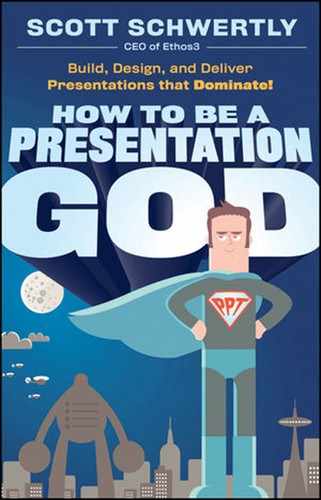10.2. GET OUT OF LINE
Though SlideRocket's benefits are numerous, in the grand scheme of things, we need to treat it like a logical, up-to-date improvement on PowerPoint or Keynote. Web capabilities are great, but there's no fundamental revolution of the way we design presentations here. It's slide after slide, template after template.
Then there's Prezi.com, another web-based presentation design application. Communication is almost always done in linear fashion. This makes sense, because you say, "Hello" in one moment and "Goodbye" in another (usually later) moment. Whatever happens in between has taken place chronologically. But what if the basic concepts you're putting forward aren't linear, chronological, or so neatly organized?
Prezi's favorite example is mathematics: We learn counting, the basics (addition, subtraction, multiplication, division), algebra, geometry, calculus, and so on, in that order. We treat counting as if it's separate from calculus, algebra as if the rules don't apply to geometry. Of course, this isn't so. All of these subjects are part of a greater system of mathematics; all of them are intertwined and dependent on one another. Yet we teach math in a linear fashion, thereby treating compartmentalized subjects as part of a very rigid order.
Some topics are made for Prezi, and others aren't. The simplest way I can think to distinguish this is to ask yourself a basic question during the outlining process: does a definite, step-by-step approach make the most sense, or do you find it difficult trying to decide which topic to discuss first? If the latter is your problem, Prezi may totally change your life.
Prezi gives presentation designers the opportunity to put their presentations together outside of a linear, page-by-page construct. Instead of making final decisions on content flow, you simply focus on making great individual slides and putting them together in a network of ideas. You're the expert: You get to help the audience see the big picture. What you end up with is a web-like structure with all closely related slides clustered together in relative proximity to the central theme.
Though this may sound to some like a fast track to the insane asylum, imagine the latitude you're given if your content is somewhat nebulous and you're presenting to more than one audience. Think about history: We know that taxation without representation led to the Boston Tea Party, which led to the American Revolution, which led to Walmart. But all of these events were defined by hundreds of parallel events, or even events that happened centuries earlier. Our trusty timelines don't do any sort of justice for illustrating the intricacies of world-changing events, nor will they do any favors for certain presentations.
And what about customization? Are all of your audiences identical? Sometimes. But what if you have to deliver your presentation to various recipients with different motivations and interests? Let's say you work in finance. For a given presentation, you might have to cover issues like fiscal responsibility, investment track records and professional history, current market trends, and projected growth rates. While that order may work best for potential clients, what if potential financial partners don't want to know your professional history? What if a prospective insurer is only interested in fiscal responsibility? Or what if, knowing your audience, you have a gut feeling that you need to start with projected growth rates to get their attention before addressing your own character and pedigree?
Trying to shake up your presentation flow using traditional, linear presentation design software would cause an irrevocable tangle. Trying to jump to slide 36 then back to slide 15 before moving on to slide 45 is not only difficult to remember; it's practically schizophrenic. Prezi provides you with the capability to zoom out and see the big picture, select your destination, and dial straight in. When it's time to move to a different concept, you can zoom out, select, and repeat. Meanwhile, your audience is able to see how each concept relates to the other, creating an underlying understanding of the subject matter that doesn't depend so much on chronology or A + B = C logic. If you've never considered abandoning the timeline when designing your presentation, I highly suggest visiting Prezi.com and taking a look. Again, it's not for everyone: for many presentations, the established linear logic model is best. But if you've wrestled with your content and design for days or weeks to no avail, it's possible that you need to take a markedly different approach.
